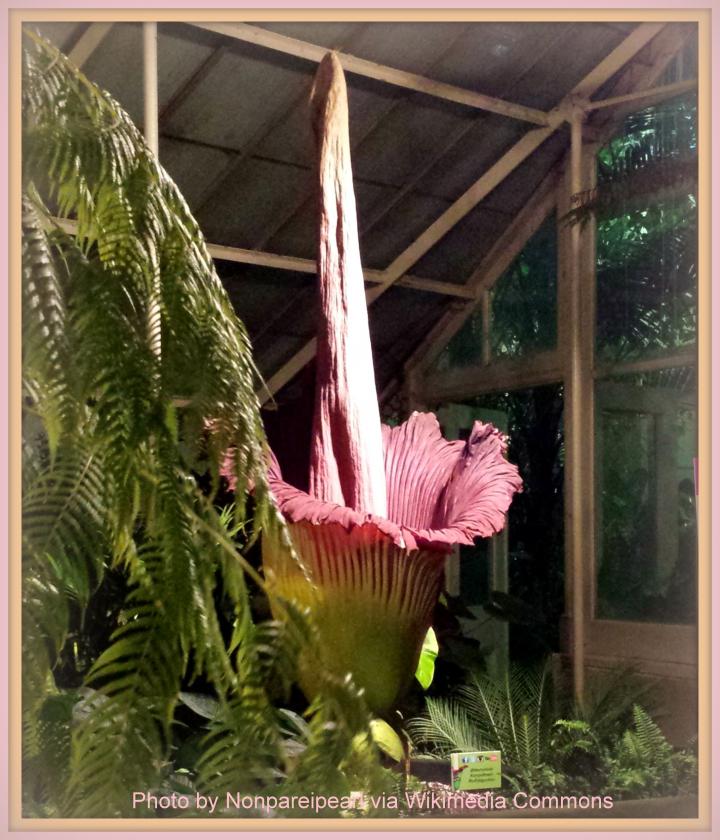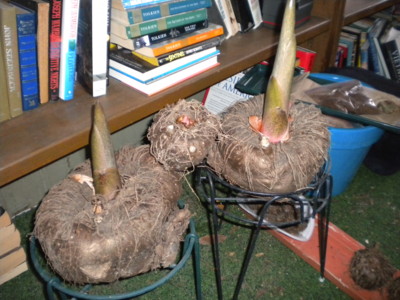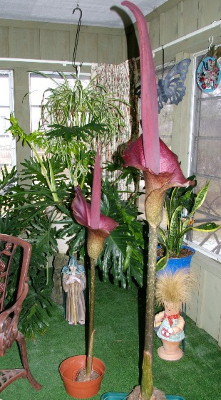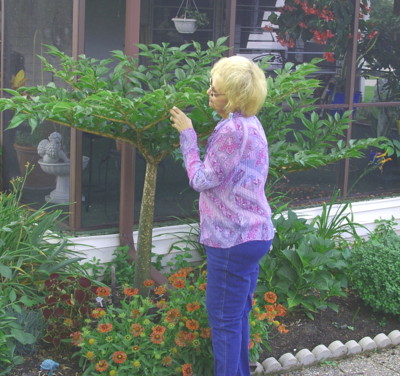





 Photo by Nonpareilpearl via Wikimedia Commons
Photo by Nonpareilpearl via Wikimedia Commons
I look forward to the vivid burgundy vase-like, stinking corpse flowers of March every year— which coincidentally flower around Easter. That is when Easter is at the end of March or early April, rather than falling so late this year.
Ten days ago I cames home to find that the previously dormant amorphophallus ‘Konjac’ bulbs I stored in the sunroom last Halloween had sprouted.
The big guy weighed 32 pounds and little one 21 pounds then. All that flesh guarantees smelly flowers of at least six feet in height by the end of March.

Bulbs sprouted in the four days I was gone and grew more than eight inches tall.
I was gone four days in early March, speaking at a couple of garden shows. Before I left, I looked at the bulbs, and they were dormant. There are also five smaller bulbs, weighing a pound or two each, which are pups or off-shoots of the big ones. All have sprouted the signature pink bud that signals growth and blooming will follow rapidly. The entire process takes only about a month.
The flowers that rise from the tubers are known for an odor likened to the aroma of rotting flesh; it attracts carrion flies that flock to dead bodies where the plants grow wild. The flies pollinate tiny flowers on the spadix of any amorphophallus in nature.

These ‘Konjac’, in their smelly glory, bloomed last year. The big one hit the ceiling.
Bulbs grow outdoors during the hotter months, and I dig them up for storage after the first killing freeze and let them dry in the garage for a month. I should say the foliage stage of the plant grows during the summer. It’s the fluorescent spathe and tiny odiferous flowers on the spadex that arise from naked bulbs in early spring.
After bulbs bloom and the huge stem, spathe and spadix sink into a mushy pool of rot, they rest a couple of months. I plant them outdoors at the end of May when any chance of a freeze is gone. A single bud again emerges to grow into a five-to-six-foot-tall maroon and green mottled stalk. Atop that a single whirl of tropical-looking leaves appear. Plants add a lush tropical look to the garden.

‘Konjac’ adds a tropical feeling to any garden during the summer.
After the first freeze or two in the fall, that stalk collapses into a pool of mush. Meanwhile, the tuber has increased in size and spawned others.
‘Konjac’ is grown as a crop in India, China, Japan and Thailand and used to create a flour and jelly of the same name. It is also used as a vegan substitute for gelatin. Shirataki noodles are made from the jelly, too, and they have zero carbohydrates, zero calories and no gluten. They perfect for diabetics and gluten-free diets.
The bulbs are in the west-facing bay window of the living room now, growing six to eight inches in height daily. I’ll let them unfurl there and enjoy their “purplessence” beauty, but when the stench begins, they will be banished to the sealed sunroom, as they were in previous years.
By April 1st, we should be treated to a gut-wrenching stench and a huge purple lily-like spathe that will be the biggest April Fool’s Day joke I can pull on friends and neighbors.
See my prior post on how I got my first corpse flower in, “My Dream Come True: The Smelliest Flower in the World.”
~ By Doreen G. HowardGet inspired by Robin Sweetser's backyard gardening tips. Robin has been a contributor to The Old Farmer's Almanac and the All-Seasons Garden Guide for many years. She and her partner Tom have a small greenhouse business and also sell plants, cut flowers, and vegetables at their local Farmer's Market.
Copyright © www.100flowers.win Botanic Garden All Rights Reserved